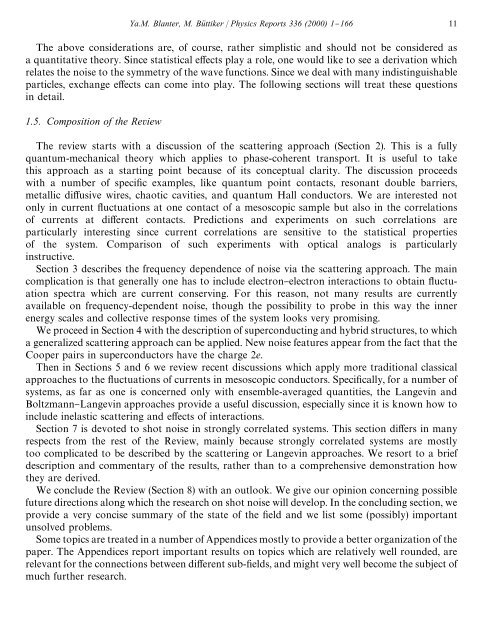shot noise in mesoscopic conductors - Low Temperature Laboratory
shot noise in mesoscopic conductors - Low Temperature Laboratory
shot noise in mesoscopic conductors - Low Temperature Laboratory
Create successful ePaper yourself
Turn your PDF publications into a flip-book with our unique Google optimized e-Paper software.
The above considerations are, of course, rather simplistic and should not be considered as<br />
a quantitative theory. S<strong>in</strong>ce statistical e!ects play a role, one would like to see a derivation which<br />
relates the <strong>noise</strong> to the symmetry of the wave functions. S<strong>in</strong>ce we deal with many <strong>in</strong>dist<strong>in</strong>guishable<br />
particles, exchange e!ects can come <strong>in</strong>to play. The follow<strong>in</strong>g sections will treat these questions<br />
<strong>in</strong> detail.<br />
1.5. Composition of the Review<br />
Ya.M. Blanter, M. Bu( ttiker / Physics Reports 336 (2000) 1}166 11<br />
The review starts with a discussion of the scatter<strong>in</strong>g approach (Section 2). This is a fully<br />
quantum-mechanical theory which applies to phase-coherent transport. It is useful to take<br />
this approach as a start<strong>in</strong>g po<strong>in</strong>t because of its conceptual clarity. The discussion proceeds<br />
with a number of speci"c examples, like quantum po<strong>in</strong>t contacts, resonant double barriers,<br />
metallic di!usive wires, chaotic cavities, and quantum Hall <strong>conductors</strong>. We are <strong>in</strong>terested not<br />
only <strong>in</strong> current #uctuations at one contact of a <strong>mesoscopic</strong> sample but also <strong>in</strong> the correlations<br />
of currents at di!erent contacts. Predictions and experiments on such correlations are<br />
particularly <strong>in</strong>terest<strong>in</strong>g s<strong>in</strong>ce current correlations are sensitive to the statistical properties<br />
of the system. Comparison of such experiments with optical analogs is particularly<br />
<strong>in</strong>structive.<br />
Section 3 describes the frequency dependence of <strong>noise</strong> via the scatter<strong>in</strong>g approach. The ma<strong>in</strong><br />
complication is that generally one has to <strong>in</strong>clude electron}electron <strong>in</strong>teractions to obta<strong>in</strong> #uctuation<br />
spectra which are current conserv<strong>in</strong>g. For this reason, not many results are currently<br />
available on frequency-dependent <strong>noise</strong>, though the possibility to probe <strong>in</strong> this way the <strong>in</strong>ner<br />
energy scales and collective response times of the system looks very promis<strong>in</strong>g.<br />
We proceed <strong>in</strong> Section 4 with the description of superconduct<strong>in</strong>g and hybrid structures, to which<br />
a generalized scatter<strong>in</strong>g approach can be applied. New <strong>noise</strong> features appear from the fact that the<br />
Cooper pairs <strong>in</strong> super<strong>conductors</strong> have the charge 2e.<br />
Then <strong>in</strong> Sections 5 and 6 we review recent discussions which apply more traditional classical<br />
approaches to the #uctuations of currents <strong>in</strong> <strong>mesoscopic</strong> <strong>conductors</strong>. Speci"cally, for a number of<br />
systems, as far as one is concerned only with ensemble-averaged quantities, the Langev<strong>in</strong> and<br />
Boltzmann}Langev<strong>in</strong> approaches provide a useful discussion, especially s<strong>in</strong>ce it is known how to<br />
<strong>in</strong>clude <strong>in</strong>elastic scatter<strong>in</strong>g and e!ects of <strong>in</strong>teractions.<br />
Section 7 is devoted to <strong>shot</strong> <strong>noise</strong> <strong>in</strong> strongly correlated systems. This section di!ers <strong>in</strong> many<br />
respects from the rest of the Review, ma<strong>in</strong>ly because strongly correlated systems are mostly<br />
too complicated to be described by the scatter<strong>in</strong>g or Langev<strong>in</strong> approaches. We resort to a brief<br />
description and commentary of the results, rather than to a comprehensive demonstration how<br />
they are derived.<br />
We conclude the Review (Section 8) with an outlook. We give our op<strong>in</strong>ion concern<strong>in</strong>g possible<br />
future directions along which the research on <strong>shot</strong> <strong>noise</strong> will develop. In the conclud<strong>in</strong>g section, we<br />
provide a very concise summary of the state of the "eld and we list some (possibly) important<br />
unsolved problems.<br />
Some topics are treated <strong>in</strong> a number of Appendices mostly to provide a better organization of the<br />
paper. The Appendices report important results on topics which are relatively well rounded, are<br />
relevant for the connections between di!erent sub-"elds, and might very well become the subject of<br />
much further research.
















